8. Freiwillgen Sturmbrigade der SS FRANKREICH
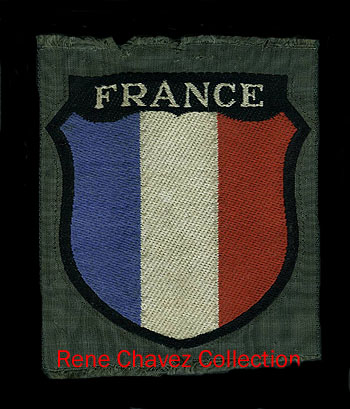
Before incorporating the LVF into the Waffen-SS, individual
Frenchmen of German heritage had successfully enlisted in SS
formations. From the very start of the occupation, these men
served under the "TOTENKOPF," "DAS REICH" and "WIKING" Divisions.
In July 1943, recruiting office was set up at 24 avenue du Recteur
Poincare in Paris where some 1500 applications were received.
University students were prominent among the volunteers.
By August 1943, 800 French candidates were drafted into the
Waffen-SS and sent to a training camp at Sennheim in Alsace.
In November 1943, 20 French Officers were sent to the SS training
camp at Bad Tolz and 100 NCO's to SS school at Posen Treskau.
The French volunteers received German Waffen-SS uniforms. In
March 1944, 1538 Frenchmen along with trained Officers and NCO's
were assembled as a complete formation at the Waffen-SS training
camp located at Beneschau near Prague. On 30 June 1944, the
unit was designated as the "8. Freiwilligen Sturmbrigade Frankreich."
Other sources referred to the brigade number as 7th, nevertheless
the French unit was commonly referred as the "SS Sturmbrigade
Frankreich."
In July 1944, the Sturmbrigade was ordered to form an emergency battle group. The 1st
battalion under the command of SS-Haupsturmführer Pierre Cance was selected for the
Eastern Front. Henri Fenet was in charged of the 1st Company.
In early August the 1st battalion was sent to reinforce the battle group of the
"18th SS Division HORST WESSEL." This division was engaged at Mielec in the
bend of the Vistula Front.
These men fought with great courage, earning praise from the commander of the 18th SS Division, SS-Oberführer Trabandt. In that battle the French lost 7 Officers and 130 men killed with 661 wounded. A total of 58 2nd class Iron Crosses were awarded, (many posthumously).
They were pulled out of the frontline and sent to regroup at Schwarnegast near Danzig.
Meanwhile, the 2nd battalion was transferred to the Waffen-SS barracks in West Prussia, northeast of Konitz, where it was joined by survivors of the 1st battalion. In September 1944, the assault brigade, French Navy personnel and members of the LVF were united to form a Waffen-SS Grenadier-Brigade. By this date much of France had been liberated and hundreds of French collaborators were evacuated along with the retreating German Wehrmacht. Himmler managed to draft various groups of retreating Frenchmen in order to complete the new Waffen-SS division, the "33. Waffen Grenadier-Division der SS Charlemagne."
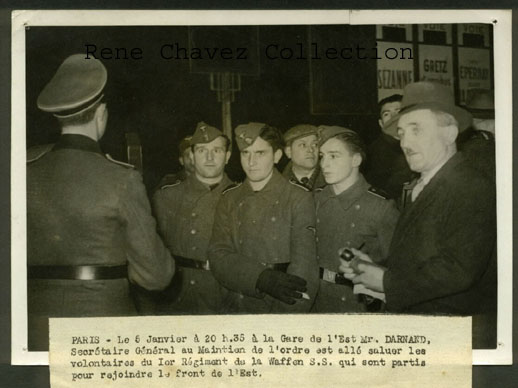
|
|
Never before seen SS propaganda picture showing the Vichy General Secretary Joseph Darnand
who was granted an honorary commission as an SS-Obersturmführer shown here visiting French SS volunteers of
the 1st Regiment before departing to the Eastern Front.
|
|
33. Waffen Grenadier-Division der SS CHARLEMAGNE
This division was composed of 7340 men and was divided into two regiments. The 57th Regiment had former LVF and the 58th Regiment formed from SS Sturmbrigade and Milice personnel. The divisional commander was German SS-Brigadeführer Dr. Gustav Krukenberg, second in command former LVF, Edgar Puaud with the rank of Waffen-Oberführer The division was placed at Wildflecken Depot station, about 40Kms away from Schweinfurt, Germany. Many Frenchmen were selected for special training and were dispatched to courses in remaining areas of the Reich. The division was provided with leftover German and Italian armament and provisions.
On 24 February 1945, two regiments of the division without divisional support were sent to the front lines near the railroad station in the village of Hammerstein.
The Division was attached to the German XVIII Gebirgs-Korps of the 2nd Army, commanded by General Houchbaum, which was part of Army Group Vistula in Pomerania. The Corps was tasked to defend a front line running from Landeck to Konitz, 45 Kms long. The Corps had already two Divisions defending the region, the German 32nd Infantry Pomeranian Division and the 15th Waffen-SS Latvian Division.
Meanwhile the Russians were already launching an offensive attack near Hammerstein-Neustettin Sector. The SS-French troops unaware what was going on went on the offensive but were immediately pull back towards Hammerstein from the Russian onslaught. Orders were immediately given to have the SS-French troops to assemble at Neustettin.
|
The Battle of Körlin
By midday on the 26th February 1945,
the bulk of the SS-French Division had reached Neustettin. Of the 4500 troops that formed the Division, 1000
of them including 15 officers were missing in action. Overall about 50 Russian tanks were destroyed and
inflicted more then double of Russian casualties.
At Neustettin about thirty Iron Crosses were awarded.
On the 27th of February two convoys carrying the remaining elements of the II/58 Regiment and
the FLAK Co as well as eight 105mm howitzers of the Artillery Group arrived at Neustettin.
Unfortunately the town of Neustettin was already being surrounded and attacked by Russian forces.
A decision was made to evacuate the town and reform at the town of Belgard, which was 72 Kms away.
About 250 men stayed behind in defensive positions to guard the withdrawal of the Charlemagne and remaining
German units.
This caused the French forces to re-organize on the 1st of March 1945, near the town of Belgard with three small battle groups.
By the 2nd of March 1945, the new organization consisted of the following battle groups:
The first group was referred as the 1st "Régiment de Marche," which had the best elements of Waffen-Gren.
der SS 57, under the command of Waffen-Ostuf. Fenet.
The second group was the 2nd "Régiment de Marche" of the Waffen-Gren, Rgt. der SS 58,
which was mostly made up of ex-LVF and Miliciens under the command of W-Hstuf. Bassompierre.
The third group was the "Régiment de Reserve" unit composed of two small battalion size groups placed under
the command of Hstuf. Monneuse.
On the 2nd of March, Brigf. Krukenberg received orders from headquarters to move to the town of Körlin and set up defensive
positions, which was 8 kms north-west of Belgard, in order to contain the Russian offensive.
By the 5-7 March 1945, the remnants of the Charlemagne Division was already surrounded by
strong Russian forces at Körlin. Regiment size battle groups were preparing to breakout
from Körlin towards Belgard.
One battle group the "Régiment de Reserve," which was under the Command of Waffen-Hstuf. de Bourmont tried to escape
through the woods under cover of the fog, unfortunately the fog cleared, and they were exposed to
a murderous fire from the Russian artillery. Oberführer Puaud was among those missing.
Another battle group, the 2nd "Régiment de Marche," thought that the Baltic ports were in enemy hands and
attempted a fighting retreat westward.
All were either killed or taken captive including the Commander W-Ostuf. Bassompierre.
The third group, the 1st "Régiment de Marche," under the Command of W-Osuf. Fenet made it in the
woods south of Belgard undetected.
Eventually reaching the Baltic Coast in Danzig but was trapped in a pocket.
SS-Brigaderführer Krukenberg, received orders to evacuate his remaining troops via
the German Navy. The remnants split into small groups and dispersed in all directions. During this withdrawal,
the group of mostly LVF veterans engaged ex-German POWs of the "Seydlitz Division." This German Division fought
on the Soviet side.
On the 10th March the French SS reached the Oder and crossing by pontoon bridge they broke
the Soviet circle. In mid-March all that was left of the division regrouped at Neustrelitz. A regimental strength
and a small battalion size of men were reorganized.
|
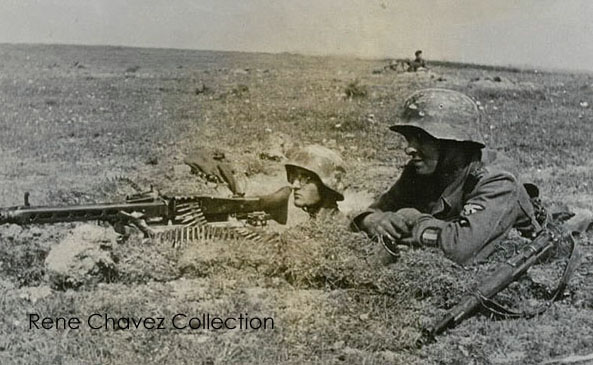
Press photo showing two French SS men dug in an underground trench.
The soldier manning the machine-gun looks like Henri Fenet.
He would later fight defending Berlin earning him the Knight Cross.
In the background you can see another trench with some soldiers, one of them is wearing
what seems to be a black fur cap. Notice the clear image of the soldier wearing a
German issued "French SS" shield attached on the left sleeve of his SS uniform.
The helmets are void of any insignia they seem well worn or smother with mud and dirt.
|
|
The Battle of Berlin
In Neustrelitz, Krukenberg received a telegram ordering him to
reach Berlin with one battalion. He asked for volunteers, those who didn't want to continue fighting were absolved,
one officer and 300 other ranks elected to call it quits.
In spite of fighting a loosing war 500 men volunteered.
They eventually reached Neukolln, East Berlin. However, due to the very heavy Russian air attack 100 of them
perished on their way.
In East Berlin the remaining 400 men were attached to the 11th SS Panzer-Grenadier Division
Nordland. They fought with undeniable heroism and terrible losses, 30 Russian tanks were destroyed at the very
beginning of the battle. Street fighting raged on, within a week it's strength had been reduced to 120 men. Every
street and house was hotly contested by French SS men.
By 29 April, 60 more Russian tanks had been knockout.
Such was the courage of the "CHARLEMAGNE" Division.
Three Frenchmen "Apolot" "Fenet" and "Vaulot" have received
the Knights Cross to the Iron Cross during the Battle for Berlin.
It is estimated that more than 100,000 Frenchmen collaborated with the Germans during World War II.
It should be noted that Frenchmen from Alsace and Lorraine were drafted into the German Army. Alsace and Lorraine was
annexed by Germany on August 1940.
|
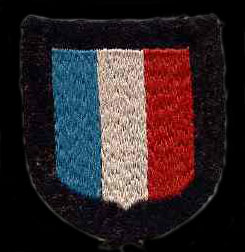
Official Waffen-SS French Tricolore Shield
In July
1944, the first official SS pattern French shield was introduced
in the Neweklau training camp during the formation of the French
SS-Sturmbrigade. This shield differed noticeably from the LVF
counterpart because it only shows the national tricolore stripes
on a black field. Interestingly upon receipt of the first French
sleeve shields it was the German instructors who were first to
sport them, whereas the Alsatian NCOs held out as long as possible.
According to SS-FHA regulations the national shield was to be
worn on the left sleeve directly under the SS sleeve eagle as
shown in the example below.
|
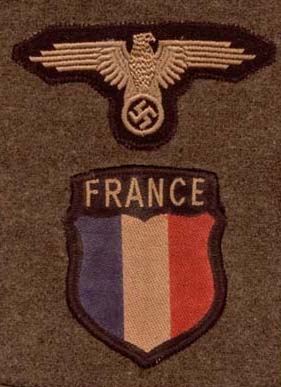
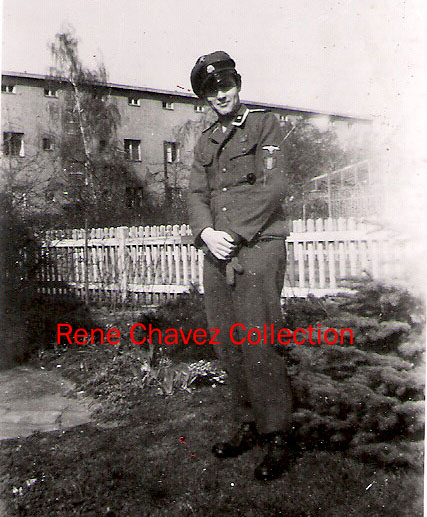
This is another SS official pattern variation noticeably similar to the LVF counterpart but with curved
sides and the word "FRANCE" at the top. In spite of SS regulations most wore the shield on the forearm.
It should be noted that privately made insignia was worn prior to its official introduction. Notice
the sleeve SS eagle, commonly referred by collectors as the "Hammerhead" eagle.
On the right shows a French SS NCO wearing the French BeVo sleeve arm-shield.
|
EKII and EKII Award
Document to Frenchman in the Charlemagne Division
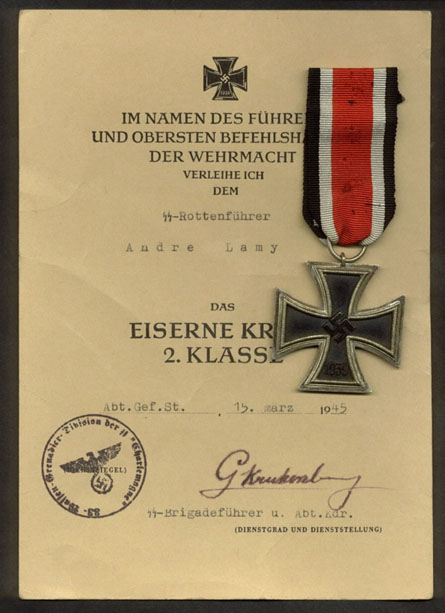
During January and early February 1945
the French SS Brigade was expanded into the
"33. Waffen-Gren der SS Charlemagne." The
defensive battles in Pomerania started on the 23 February 1945 with the
Charlemagne Division refitting at Hammerstein Camp. On 8 March 1945, the
remnants of the Division assembled in Jargelin North-west of Anklam. During that
time Brigaderführer Krukenberg awards 16 EKII to French volunteers. The EKII
Document was given to SS Rottenführer Andre Lamy. It is dated 15 March 1945
and handstamped with the Divisional Seal of the Charlemagne. The document also
has the signature of SS-Brigadeführer Krukenberg who would later command the
remaining remnants of the Nordland Division.
Also shown is the original EKII awarded to the Charlemagne volunteer.
|
|






